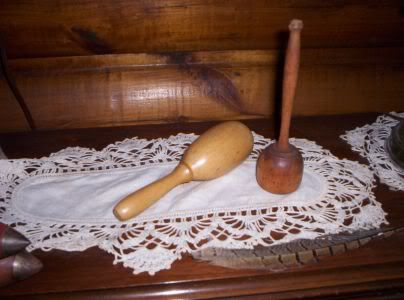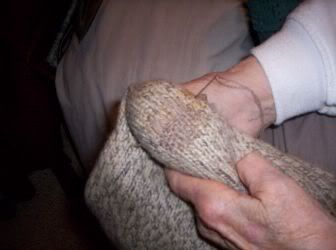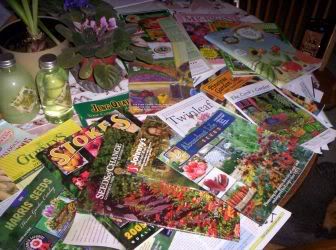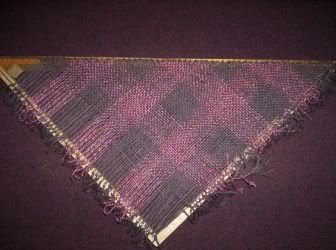
I am back after a winter respite at my mothers house, where I relaxed and enjoyed countless hours of conversation and fiber arts. One of the projects that I worked on was learning how to darn socks. My mother taught this to me years ago (when I was to young to pay close attention to what she was doing), and it is a technique which I do not use often enough to remember what I did the time before. I figured it was a good time for a refresher course.
My mother just happened to have a pair of socks ready for mending. My brother had given them to her a few weeks ago. They were a nice pair of woolen socks, in very good condition, except for the hole that he had worn in the back of the heel.
To darn the socks, it is helpful to have a
darning tool. The most common ones look like an egg stuck on the end of a stick, but there are some
very beautiful vintage ones that can be found in antique stores, or even on e-bay! The sock darners pictured above are my own. I keep an eye out for them when I am shopping at yard sales, but there are not as many around as there used to be.
The darning tool is slipped inside the sock to provide a surface to work on. You can easily position the tool where you are most comfortable working with it. To begin darning, my mother first selected the thread/yarn that she wanted to use. It was Fortissoma wooly nylon yarn made for socks. With the help of a needle threader (another handy dandy tool), she thread a single strand of the Fortissoma. Being careful not to knot the thread, she left the tail about 1/4 to 1/2 inch long and started to baste a stitch in the shape of a circle around the perimeter and approx. 1/4 inch from the hole in the sock. Once the circle was complete, she stitched up and down along the inside of the circle, forming a sort of warp and working from one side to the other. When this was accomplished, she began weaving over and under the warp she had just created. By the time she was finished, the hole was no longer visible.

My brother was delighted with the repair job. He really did a double take, looking closely at the socks to see if he could find where the hole used to be. I know he was impressed, and may be thinking of learning how to darn! I imagine it would be fairly easy to learn for anyone who feels comfortable with a needle and thread. In this "throw away society" that we now live in, it is fun to take a little bit of time to give an article of clothing a little more mileage. I would never spend the time darning a sock that I brought at say, Walmart...but for the socks and gloves and mittens that we take the time to knit, it is a task that is definitely worth knowing how to do.
On the weather front, we are expected to get 12+ inches of snow tonight and tomorrow. Snow in February is quite different from snow in December, and it will not be around for long before the fog eats it up. The subtle signs of spring are here, even in the midst of the snow. The days are getting steadily longer, the buds on the maple are swelling just slightly and the mourning doves are starting to pair up. You can feel the change in the air, and that change means certainty. Sure it will snow, but it won't last...the sun will see to that.
I read an interesting article about snow the other day...
Researchers keep ear to the snow
 New-fallen or slushed, it offers a study in acoustics, an accumulation of sound data.
New-fallen or slushed, it offers a study in acoustics, an accumulation of sound data. By Dawn Fallik
By Dawn Fallik Inquirer Staff Writer
Inquirer Staff Writer
Freshly fallen snow is really nature's white-noise machine.
That's right. It really is quiet after a snowfall, and not just because everyone is hiding indoors.
Scientists have discovered that in the first hours after a snowfall, the flakes possess a rare acoustic quality, the ability to absorb sound waves.
To continue reading this article...click here.






